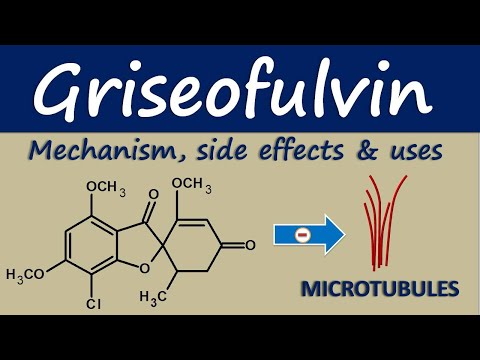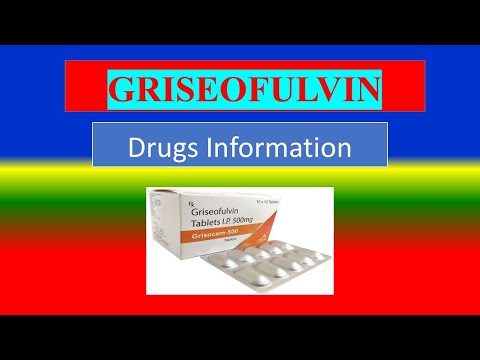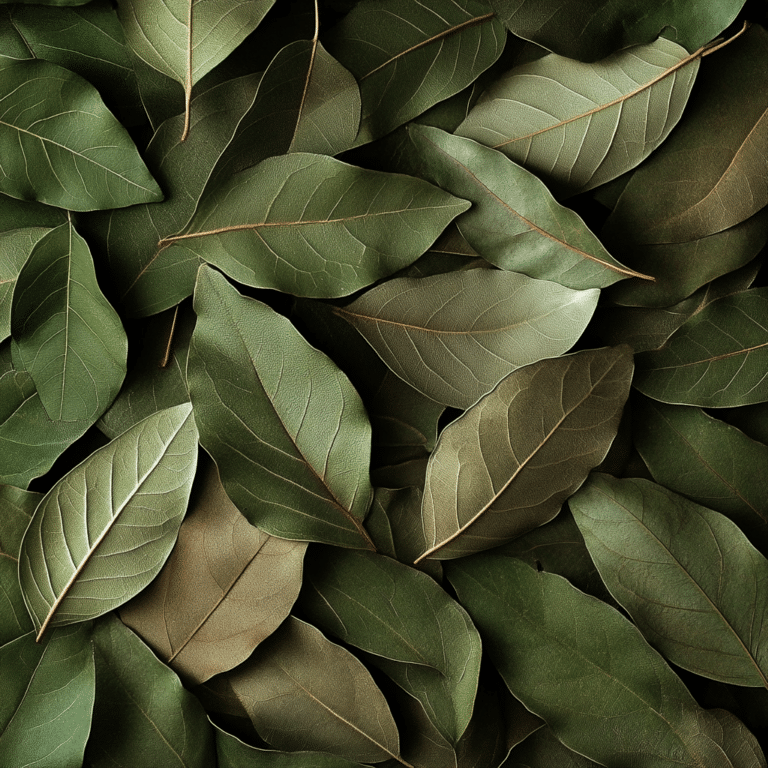Fellas, if you’re hitting the gym hard, pushing those weights, and striving for that chiseled physique, it’s crucial to stay healthy. But what happens when a sneaky fungal infection gets in your way? Meet griseofulvin—your powerful ally against those irritating fungal infections that can mess with your fitness game. Derived from the mold Penicillium griseofulvum, this antifungal champion is primarily used to tackle infections on your skin, hair, and nails. It halts fungal growth, disrupts reproduction, and gets you back on that fitness grind faster than a bodybuilder on post-workout protein.
So, what makes griseofulvin tick? This medication works by inhibiting fungal cell growth and messing with its mitotic spindle formation—basically, it stops those pesky fungi in their tracks. It’s particularly effective against the dermatophyte species Trichophyton, Microsporum, and Epidermophyton. When topical treatments just won’t cut it, griseofulvin comes to the rescue, helping you maintain your aesthetic goals without setbacks.

Understanding Griseofulvin and Its Mechanism of Action
Griseofulvin isn’t just another medication—it’s a specialized solution to a common problem. When fungal infections like athlete’s foot or ringworm start cramping your style, attune your focus to griseofulvin. It creates rough terrain for the fungi, starving them of opportunities to grow and reproduce.
When you take griseofulvin, you’ll find it gets absorbed into your bloodstream, where it travels to serve its purpose. Instead of playing a waiting game, griseofulvin gives you the edge in treatment, particularly when other methods fall short. Particularly for athletes, staying healthy and infection-free means maintaining that training schedule without interruptions. Griseofulvin has got your back (and your skin, nails, and hair)!

Top 7 Facts About Griseofulvin
1. FDA Approval and Forms
Let’s kick things off with a little history lesson. Griseofulvin received FDA approval back in the 1950s and has been a stalwart in antifungal treatments ever since. It shows up in a couple of forms—griseofulvin micronized and ultramicrosized. The ultramicrosized version enhances absorption, letting you get on with your life quicker and with fewer pills to swallow.
2. Indications Beyond Fungal Infections
While our focus here is on those annoying fungal infections, griseofulvin has some tricks up its sleeve. It’s also playing a role in treating tinea capitis in children and can serve as a helpful adjunct for more severe dermatological conditions like seborrheic dermatitis. So, whether it’s in the locker room or at the beach, being fungal-free has never been easier.
3. Comparison with Other Antifungal Medications
Now, let’s break down how griseofulvin stacks up against the competition. You might hear names like terbinafine (Lamisil) and fluconazole (Diflucan) tossed around, but griseofulvin sets itself apart by focusing specifically on dermatophytes. While terbinafine offers quick relief for nail infections, griseofulvin tends to require a longer commitment. As for fluconazole, it’s a formidable ally against candidal infections but doesn’t touch dermatophyte treatments like griseofulvin does.
4. Side Effects and Management
Every hero has its hurdles, and griseofulvin is no different. Common side effects include gastrointestinal issues, headaches, and even a bit of dizziness. Keep an eye on your liver function during treatment, as the drug gets metabolized there. And remember, it can make you more sensitive to sunlight—don’t forget that sunscreen when you’re outside!
5. Interactions with Other Medications
Before you mix and match medications, keep in mind that griseofulvin can interact with some others. For instance, it can reduce the effectiveness of olmesartan (Benicar), which is a bummer for anyone relying on that for blood pressure control. If you’re also on anticonvulsants like briviact (brivaracetam), you might need to adjust those doses since griseofulvin can alter metabolism in the liver.
6. Griseofulvin vs. Other Treatments
When you look at the spectrum of treatments available, griseofulvin maintains a specialty status. Unlike newer alternatives like Auvelity (a depression treatment), griseofulvin zeroes in on fungal infections. Even over-the-counter solutions like Claritin-D don’t cut it; they’re aimed at allergy symptoms, while griseofulvin is on a mission for fungal eradication.
7. Long-term Efficacy and Resistance
Let’s get real for a moment. While griseofulvin has stood the test of time, the rise of fungal resistance is something we need to keep an eye on. Researchers are actively working to understand these resistance patterns, ensuring we have effective options even when griseofulvin isn’t the answer.

Real-World Success Stories: Griseofulvin in Action
To really showcase griseofulvin’s incredible effectiveness, let’s dig into some real-life success stories. Picture a young athlete battling tinea capitis—the kind that sidelines you from practices and games. After starting a griseofulvin treatment schedule and sticking to it like a champion, that athlete was back to full strength and ready to crush it in practice.
On the flip side, consider an adult who struggled with recurrent tinea pedis. After drowning in a sea of ineffective topical treatments, griseofulvin came in like a superhero. Fast forward a few weeks, and that person could walk around barefoot again, living life without the dread of itchy, annoying infections.
These testimonials will help anyone dealing with fungal infections understand that, yes, griseofulvin works wonders when you leverage it correctly.

The Future of Antifungal Treatments
Looking ahead, there’s hope on the horizon. As research progresses, we’re discovering new compounds and treatments that enhance the realm of antifungal therapies. Integrative treatment plans that combine griseofulvin with biological therapies could elevate success rates for chronic infections. Personalized medicine, thanks to pharmacogenomics, is setting us up for a future where antifungal treatments are crafted to fit individual needs—pretty impressive stuff!
So there you have it, folks. Griseofulvin is a critical player today and promises to remain pivotal in the fight against fungal infections. As we stride into 2024, let’s prioritize education about resistance challenges and the importance of treatment options like griseofulvin. Keep smashing those goals, and remember to be the best version of yourself—fungal-free!
To find out more about How The gringo stole christmas, taylor swift london Tickets, or even delve into concepts like dna meaning, be sure to check out the latest articles. Also, don’t fall into analysis paralysis when it comes to your health; knowing about griseofulvin can empower you to take charge! Remember, your health is your most valuable asset, so protect and optimize it as you work toward that ultimate six-pack!

Exploring Griseofulvin: Fun Facts and Trivia
The Origins of Griseofulvin
Did you know that griseofulvin has been around since the 1950s? This antifungal agent, derived from the Penicillium fungus, was a game-changer for treating conditions like ringworm and athlete’s foot. Remarkably, the spotlight on griseofulvin came at a time when many other treatments were scarce. Back then, it stood out as a beacon of hope for those grappling with persistent fungal infections, a real lifesaver for many, including gay men who often faced stigma in seeking treatments for such skin conditions.
How Griseofulvin Works Its Magic
When griseofulvin enters the body, it targets rapidly dividing fungal cells, interrupting their replication. Picture it like a lock—a key that prevents fungi from spreading and causing further trouble. This targeted action is vital in treating infections effectively. As it works, some folks might even wonder about their own health—perhaps why this fascinating compound doesn’t have home-like remedies making the rounds, instead of relying solely on the knowledge gleaned from health resources that often define essence simply. Knowing how griseofulvin acts not only aids in understanding fungal infections but also illustrates the brilliance of nature’s pharmacy.
Trivia to Spark Your Curiosity
Here’s a little nugget for you: despite being a treatment for fungal infections, griseofulvin itself doesn’t work well against every type of fungi. While it’s superb for dermatophytes, it falls short with certain yeasts and molds. That said, it’s an example of how specific treatments must be in the vast landscape of medicine, much like how one might rate mortgages—each tailored to fit unique needs. Plus, did you know that the same compound has been researched for various uses beyond antifungal treatments? Scientists are investigating its potential roles in everything from skin cancer treatment to anti-inflammatory applications. Talk about an unexpected twist!
With that said, as you consider the impact of griseofulvin on health, it’s like an impressive performance akin to the bold storytelling found in La Sirena 69, drawing us into the narrative of human resilience and recovery. So next time you hear about this power-packed medication, remember the layers beneath it—it’s not just about treating infections but about the broader conversation around health and wellness in our society.



























